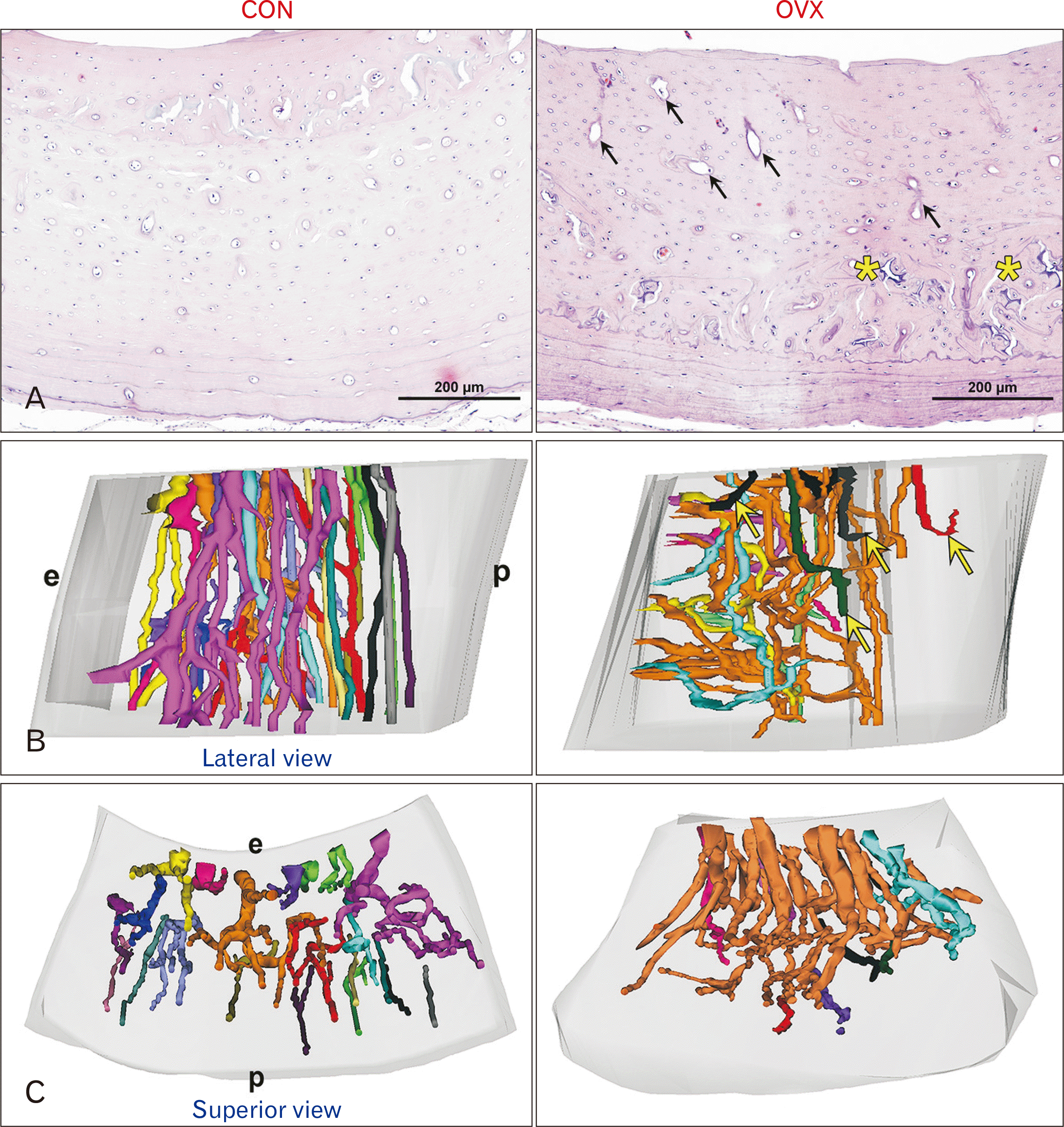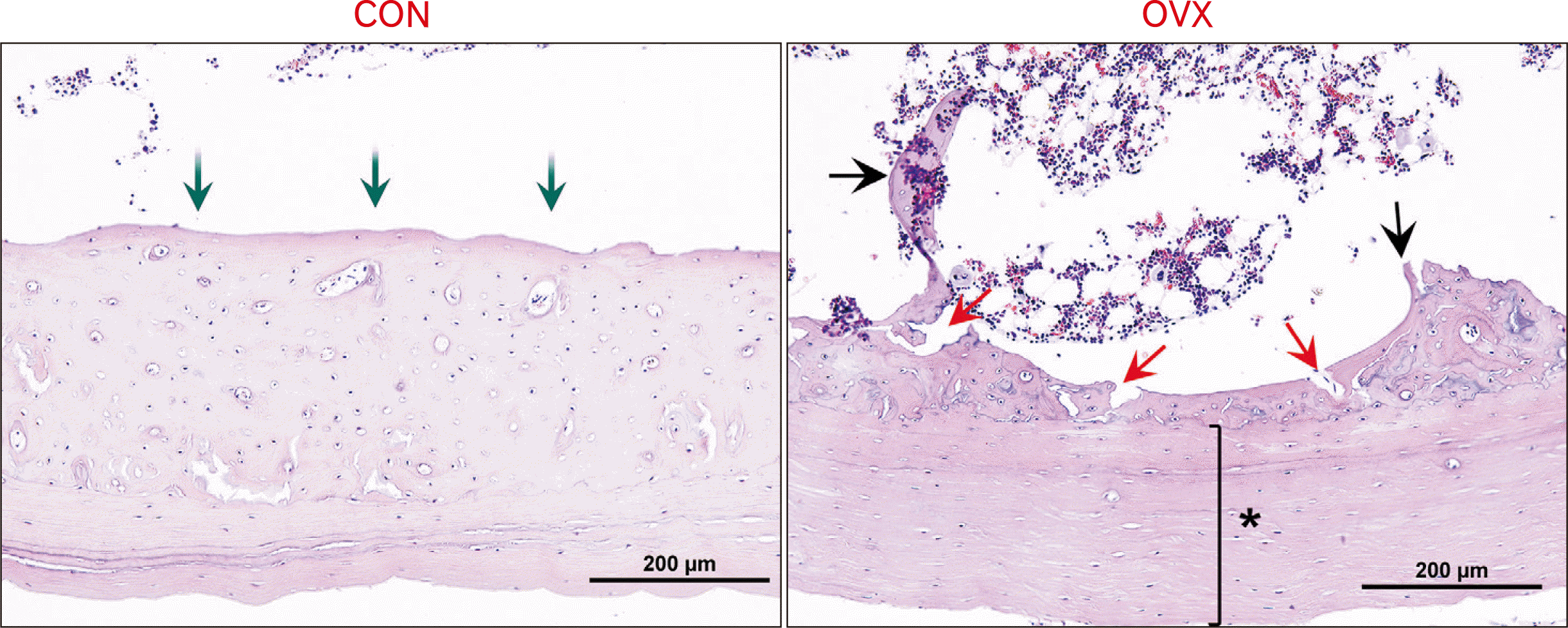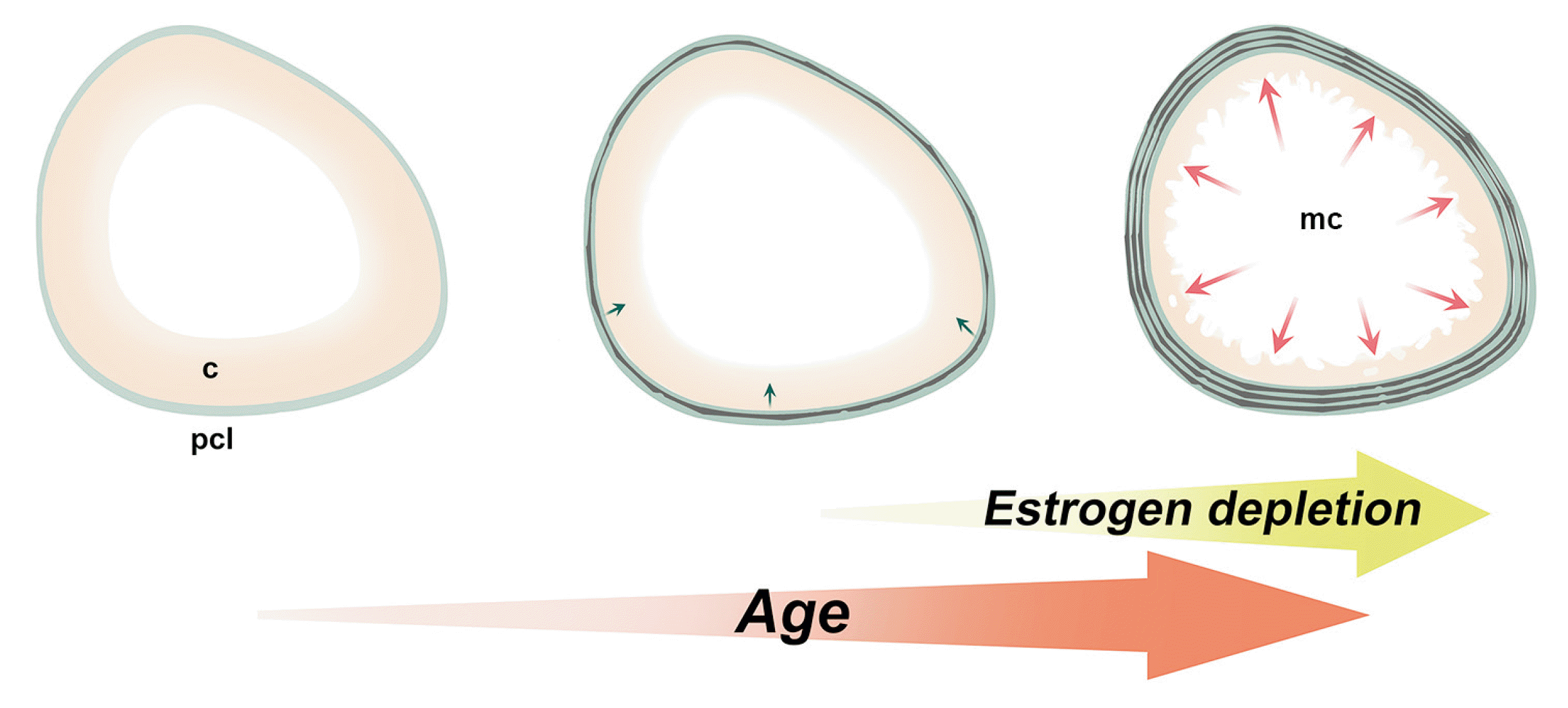1. Wang J, Stein EM, Zhou B, Nishiyama KK, Yu YE, Shane E, Guo XE. 2016; Deterioration of trabecular plate-rod and cortical microarchitecture and reduced bone stiffness at distal radius and tibia in postmenopausal women with vertebral fractures. Bone. 88:39–46. DOI:
10.1016/j.bone.2016.04.003. PMID:
27083398. PMCID:
PMC4899124.

2. Pavel OR, Popescu M, Novac L, Mogoantă L, Pavel LP, Vicaş RM, Trăistaru MR. 2016; Postmenopausal osteoporosis - clinical, biological and histopathological aspects. Rom J Morphol Embryol. 57:121–30. PMID:
27151697.
4. Britz HM, Thomas CD, Clement JG, Cooper DM. 2009; The relation of femoral osteon geometry to age, sex, height and weight. Bone. 45:77–83. DOI:
10.1016/j.bone.2009.03.654. PMID:
19303955.

5. Bentolila V, Boyce TM, Fyhrie DP, Drumb R, Skerry TM, Schaffler MB. 1998; Intracortical remodeling in adult rat long bones after fatigue loading. Bone. 23:275–81. DOI:
10.1016/S8756-3282(98)00104-5. PMID:
9737350.

6. Kennedy OD, Brennan O, Mauer P, Rackard SM, O'Brien FJ, Taylor D, Lee TC. 2008; The effects of increased intracortical remodeling on microcrack behaviour in compact bone. Bone. 43:889–93. DOI:
10.1016/j.bone.2008.07.235. PMID:
18706535.

7. Lee KC, Maxwell A, Lanyon LE. 2002; Validation of a technique for studying functional adaptation of the mouse ulna in response to mechanical loading. Bone. 31:407–12. DOI:
10.1016/S8756-3282(02)00842-6.

8. De Souza RL, Matsuura M, Eckstein F, Rawlinson SC, Lanyon LE, Pitsillides AA. 2005; Non-invasive axial loading of mouse tibiae increases cortical bone formation and modifies trabecular organization: a new model to study cortical and cancellous compartments in a single loaded element. Bone. 37:810–8. DOI:
10.1016/j.bone.2005.07.022. PMID:
16198164.

9. Popp KL, Hughes JM, Martinez-Betancourt A, Scott M, Turkington V, Caksa S, Guerriere KI, Ackerman KE, Xu C, Unnikrishnan G, Reifman J, Bouxsein ML. 2017; Bone mass, microarchitecture and strength are influenced by race/ethnicity in young adult men and women. Bone. 103:200–8. DOI:
10.1016/j.bone.2017.07.014. PMID:
28712877.

10. Carter DR, Orr TE, Fyhrie DP. 1989; Relationships between loading history and femoral cancellous bone architecture. J Biomech. 22:231–44. DOI:
10.1016/0021-9290(89)90091-2. PMID:
2722894.

11. Ishihara A, Sasaki T, Debari K, Furuya R, Kawawa T, Ramamurthy NS, Golub LM. 1999; Effects of ovariectomy on bone morphology in maxillae of mature rats. J Electron Microsc (Tokyo). 48:465–9. DOI:
10.1093/oxfordjournals.jmicro.a023703. PMID:
10510861.

12. Jee WS, Yao W. 2001; Overview: animal models of osteopenia and osteoporosis. J Musculoskelet Neuronal Interact. 1:193–207. PMID:
15758493.
13. Walker MD, Liu XS, Stein E, Zhou B, Bezati E, McMahon DJ, Udesky J, Liu G, Shane E, Guo XE, Bilezikian JP. 2011; Differences in bone microarchitecture between postmenopausal Chinese-American and white women. J Bone Miner Res. 26:1392–8. DOI:
10.1002/jbmr.352. PMID:
21305606. PMCID:
PMC3558983.

14. Johnston BD, Ward WE. 2015; The ovariectomized rat as a model for studying alveolar bone loss in postmenopausal women. Biomed Res Int. 2015:635023. DOI:
10.1155/2015/635023. PMID:
26060817. PMCID:
PMC4427799.

15. Hsu PY, Tsai MT, Wang SP, Chen YJ, Wu J, Hsu JT. 2016; Cortical bone morphological and trabecular bone microarchitectural changes in the mandible and femoral neck of ovariectomized rats. PLoS One. 11:e0154367. DOI:
10.1371/journal.pone.0154367. PMID:
27127909. PMCID:
PMC4851407.

16. Farooq S, Leussink S, Sparrow LM, Marchini M, Britz HM, Manske SL, Rolian C. 2017; Cortical and trabecular morphology is altered in the limb bones of mice artificially selected for faster skeletal growth. Sci Rep. 7:10527. DOI:
10.1038/s41598-017-10317-x. PMID:
28874773. PMCID:
PMC5585176.

17. Popp KL, Xu C, Yuan A, Hughes JM, Unnikrishnan G, Reifman J, Bouxsein ML. 2019; Trabecular microstructure is influenced by race and sex in Black and White young adults. Osteoporos Int. 30:201–9. DOI:
10.1007/s00198-018-4729-9. PMID:
30397770.

18. Basillais A, Bensamoun S, Chappard C, Brunet-Imbault B, Lemineur G, Ilharreborde B, Ho Ba Tho MC, Benhamou CL. 2007; Three-dimensional characterization of cortical bone microstructure by microcomputed tomography: validation with ultrasonic and microscopic measurements. J Orthop Sci. 12:141–8. DOI:
10.1007/s00776-006-1104-z. PMID:
17393269.

19. Standring S. 2016. Gray's anatomy: the anatomical basis of clinical practice. 41th ed. Elsevier Health Sciences;Amsterdam: p. 88.
20. Cooper DM, Thomas CD, Clement JG, Turinsky AL, Sensen CW, Hallgrímsson B. 2007; Age-dependent change in the 3D structure of cortical porosity at the human femoral midshaft. Bone. 40:957–65. DOI:
10.1016/j.bone.2006.11.011. PMID:
17223618.

22. Harrison KD, Cooper DM. 2015; Modalities for visualization of cortical bone remodeling: the past, present, and future. Front Endocrinol (Lausanne). 6:122. DOI:
10.3389/fendo.2015.00122. PMID:
26322017. PMCID:
PMC4531299.

23. Klein-Nulend J, van Oers RF, Bakker AD, Bacabac RG. 2015; Bone cell mechanosensitivity, estrogen deficiency, and osteoporosis. J Biomech. 48:855–65. DOI:
10.1016/j.jbiomech.2014.12.007. PMID:
25582356.

24. Danielsen CC, Mosekilde L, Svenstrup B. 1993; Cortical bone mass, composition, and mechanical properties in female rats in relation to age, long-term ovariectomy, and estrogen substitution. Calcif Tissue Int. 52:26–33. DOI:
10.1007/BF00675623. PMID:
8453502.

26. Pazzaglia UE, Congiu T, Pienazza A, Zakaria M, Gnecchi M, Dell'orbo C. 2013; Morphometric analysis of osteonal architecture in bones from healthy young human male subjects using scanning electron microscopy. J Anat. 223:242–54. DOI:
10.1111/joa.12079. PMID:
23834434. PMCID:
PMC3972045.

27. Westerlind KC, Wronski TJ, Ritman EL, Luo ZP, An KN, Bell NH, Turner RT. 1997; Estrogen regulates the rate of bone turnover but bone balance in ovariectomized rats is modulated by prevailing mechanical strain. Proc Natl Acad Sci U S A. 94:4199–204. DOI:
10.1073/pnas.94.8.4199. PMID:
9108129. PMCID:
PMC20601.

28. Andreasen CM, Delaisse JM, van der Eerden BCJ, van Leeuwen JPTM, Ding M, Andersen TL. 2018; Understanding age-induced cortical porosity in women: is a negative BMU balance in quiescent osteons a major contributor? Bone. 117:70–82. DOI:
10.1016/j.bone.2018.09.011. PMID:
30240959.

29. Leppänen O, Sievänen H, Jokihaara J, Pajamäki I, Järvinen TL. 2006; Three-point bending of rat femur in the mediolateral direction: introduction and validation of a novel biomechanical testing protocol. J Bone Miner Res. 21:1231–7. DOI:
10.1359/jbmr.060511. PMID:
16869721.

30. Kim JN, Lee JY, Shin KJ, Gil YC, Koh KS, Song WC. 2015; Haversian system of compact bone and comparison between endosteal and periosteal sides using three-dimensional reconstruction in rat. Anat Cell Biol. 48:258–61. DOI:
10.5115/acb.2015.48.4.258. PMID:
26770876. PMCID:
PMC4701699.

31. van Hove RP, Nolte PA, Vatsa A, Semeins CM, Salmon PL, Smit TH, Klein-Nulend J. 2009; Osteocyte morphology in human tibiae of different bone pathologies with different bone mineral density-is there a role for mechanosensing? Bone. 45:321–9. DOI:
10.1016/j.bone.2009.04.238. PMID:
19398046.
33. Hert J, Fiala P, Petrtýl M. 1994; Osteon orientation of the diaphysis of the long bones in man. Bone. 15:269–77. DOI:
10.1016/8756-3282(94)90288-7.

35. Pazzaglia UE, Congiu T, Raspanti M, Ranchetti F, Quacci D. 2009; Anatomy of the intracortical canal system: scanning electron microscopy study in rabbit femur. Clin Orthop Relat Res. 467:2446–56. DOI:
10.1007/s11999-009-0806-x. PMID:
19330389. PMCID:
PMC2866945.

36. Pazzaglia UE, Congiu T, Marchese M, Zarattini G. 2011; Structural pattern and functional correlations of the long bone diaphyses intracortical vascular system: investigation carried out with China ink perfusion and multiplanar analysis in the rabbit femur. Microvasc Res. 82:58–65. DOI:
10.1016/j.mvr.2011.02.001. PMID:
21320513.
37. Pratt IV, Cooper DML. 2018; The effect of growth rate on the three-dimensional orientation of vascular canals in the cortical bone of broiler chickens. J Anat. 233:531–41. DOI:
10.1111/joa.12847. PMID:
30022496. PMCID:
PMC6131975.

39. Jowsey J. 1966; Studies of Haversian systems in man and some animals. J Anat. 100(Pt 4):857–64. PMID:
4961449. PMCID:
PMC1270831.
40. Singh IJ, Tonna EA, Gandel CP. 1974; A comparative histological study of mammalian bone. J Morphol. 144:421–37. DOI:
10.1002/jmor.1051440404. PMID:
4457648.

41. Cvetkovic VJ, Najman SJ, Rajkovic JS, Zabar ALj, Vasiljevic PJ, Djordjevic LjB, Trajanovic MD. 2013; A comparison of the microarchitecture of lower limb long bones between some animal models and humans: a review. Vet Med. 58:339–51. DOI:
10.17221/6914-VETMED.

42. Montoya-Sanhueza G, Chinsamy A. 2017; Long bone histology of the subterranean rodent Bathyergus suillus (Bathyergidae): ontogenetic pattern of cortical bone thickening. J Anat. 230:203–33. DOI:
10.1111/joa.12547. PMID:
27682432. PMCID:
PMC5244287.
43. Shipov A, Zaslansky P, Riesemeier H, Segev G, Atkins A, Shahar R. 2013; Unremodeled endochondral bone is a major architectural component of the cortical bone of the rat (Rattus norvegicus). J Struct Biol. 183:132–40. DOI:
10.1016/j.jsb.2013.04.010. PMID:
23643909.

44. Skedros JG, Sorenson SM, Jenson NH. 2007; Are distributions of secondary osteon variants useful for interpreting load history in mammalian bones? Cells Tissues Organs. 185:285–307. DOI:
10.1159/000102176. PMID:
17587802.

45. Kanczler JM, Oreffo RO. 2008; Osteogenesis and angiogenesis: the potential for engineering bone. Eur Cell Mater. 15:100–14. DOI:
10.22203/eCM.v015a08. PMID:
18454418.










 PDF
PDF Citation
Citation Print
Print



 XML Download
XML Download